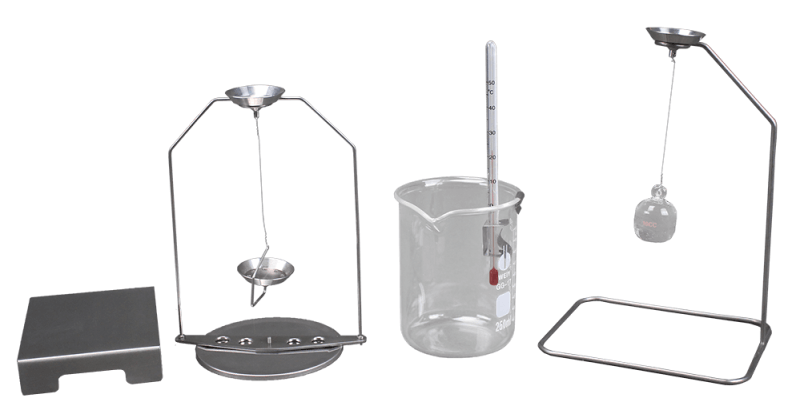
Some weighing scales come with below balance hooks or have them as an optional feature. These hooks extend your balance’s functionality by enabling you to use the balance to perform applications such as density determination and specific gravity testing. Below balance weighing hooks are a great addition to education scales and school scales like the TBB triple beam balance, since you can teach multiple lesson plans using the same balance.
Another common use of below balance weighing is to extend the balance or scale’s weighing capabilities by hanging a bigger pan to weigh large items that don’t fit on a compact scale or analytical balance. This does not mean your balance can weigh heavier items (the capacity remains the same), merely that it can weigh larger objects or quantities of things that do not fit on the standard pan; so take care to not overload the balance. It’s also useful for weighing messy items.
What you need for below balance weighing:
The optional hook, or below balance hanger, is one of the main components. A weighing table with a hole or a balance stand are necessary to keep the balance secure and stable while measuring. A string or wire to suspend the object or pan is attached to the hook. If you’re measuring density, a receptacle such as a beaker capable of containing liquids should be put under the balance. Don’t forget to use a thermometer to measure water temperature because its density changes as its temperature does. If you don’t already have all these items, density kits are available for our balances.

How density determination works with a balance
Density is defined as mass per unit volume. Adam balances typically display results as grams per cubic centimeter. If a solid material’s density is determined, it is weighed in air and then suspended in a liquid (usually water). Its volume is determined by the amount of the liquid it displaces. One can also measure the length, width and height, but something like the volume of unevenly cut gems or a ring will not be as easy to determine. The density can be determined either manually or by using software that is included in some balances. One way to determine the density of a liquid is to put the liquid in a graduated cylinder (don’t forget to tare the cylinder’s weight) and weigh the liquid. Density is mass divided by volume. Another method is to use an Adam density kit which includes a sinker of known volume. Once again, this can be calculated manually or using the balance’s software. Don’t forget that other factors such as temperature can affect density (water’s, for example).
Using density determination to distinguish gold purity
Determining the density of something is very useful. If the substance being weighed is pure, one can identify it fairly easily by using a key containing the density of specific elements and alloys. The volume and the mass of a gold chain and a gold ring will be different, but the density of gold remains the same. So no matter the size or mass, if two objects are made of the same material, they will have the same density because their volume is proportional. This means it can be used to make sure something is really made out of precious materials, or to determine what it’s made of. Determining something’s density can also tell us about its properties, such a buoyancy (does it float) or its purity (for jewelry). One famous example is Archimedes figuring out if a crown was indeed made of gold or out of a cheaper material for his king. Density kits are often sold with modified jewellery scales and gold scales for jewellers and coin collectors to determine if a piece is authentic or contains as much gold or other precious metals as they are sold as.
Density applies to everything from soil to sea, from engineering to medicine. Different soil densities are important when figuring out the fertility of said soil, while liquid density determines things like oceanic currents and properties of other fluids. When designing something like a boat or a plane, it’s important to know the density of the materials used and their properties under various conditions.
How specific gravity testing works
The name “specific gravity” is often used interchangeably with density, but they are not the same thing. Specific gravity “is the ratio of a material's density with that of water at 4 °C (where it is most dense and is taken to have the value (*) 999.974 kg·m-3) and is therefore a relative quantity with no units”. This technique is often used to identify and differentiate similar looking gems. In other industries, it is broadly used “as a simple means of obtaining information about the concentration of solutions of various materials”. It can be applied with juice, fuel, syrup, beer, acids and more. For example, you could use specific gravity testing to figure out how much actual apple juice is in a juice box, or to determine the composition of soil to see if it can be used sustainably.

Applications besides jewelry testing and science education often have other instruments to test specific gravity such as hydrometers for beer brewing. Scientific scales and balances can be specialised in density testing, but they’re generally made for jewellers and chemists rather than for the food and drink industry.
Overall, density and its determination are important parts of most industries, and whether you’re an educator, chemist or a jeweler, below balance weighing features can allow you to extend your item’s functionality.
Need a density determination kit for an analytical or precision balance?
We have many weighing scales that include below balance weighing as a feature, including the Core compact balance, the Highland precision scale, the TBB triple beam balance and the CQT portable balance, as well as many more. Visit our website to see our products, or contact us to learn more.


